Corporate and Financial Accounting Report: Four Company Analysis
VerifiedAdded on 2020/10/22
|9
|2423
|123
Report
AI Summary
This report provides a comprehensive analysis of corporate accounting practices, focusing on financial reporting, corporate regulations, and the role of the International Accounting Standards Board (IASB) and the Australian Accounting Standards Board (AASB) in setting accounting standards. The report examines the functions of financial accounting and its importance in providing information for decision-making by investors and creditors. Furthermore, it includes a detailed analysis of the equity items and debt-equity ratios of four companies: Dark Horse Resources, Aeon Metals, European Lithium, and Accent Resources. The analysis covers the issued capital, reserves, and accumulated losses of each company over a four-year period, offering insights into their financial performance and stability. The report concludes with a comparative analysis of the debt-equity positions of the four companies, highlighting the implications of different financing strategies. The report uses data from 2014-2017 to provide a comparative analysis of the debt equity position of four companies. This report is a valuable resource for students and professionals seeking to understand corporate accounting principles and financial statement analysis.
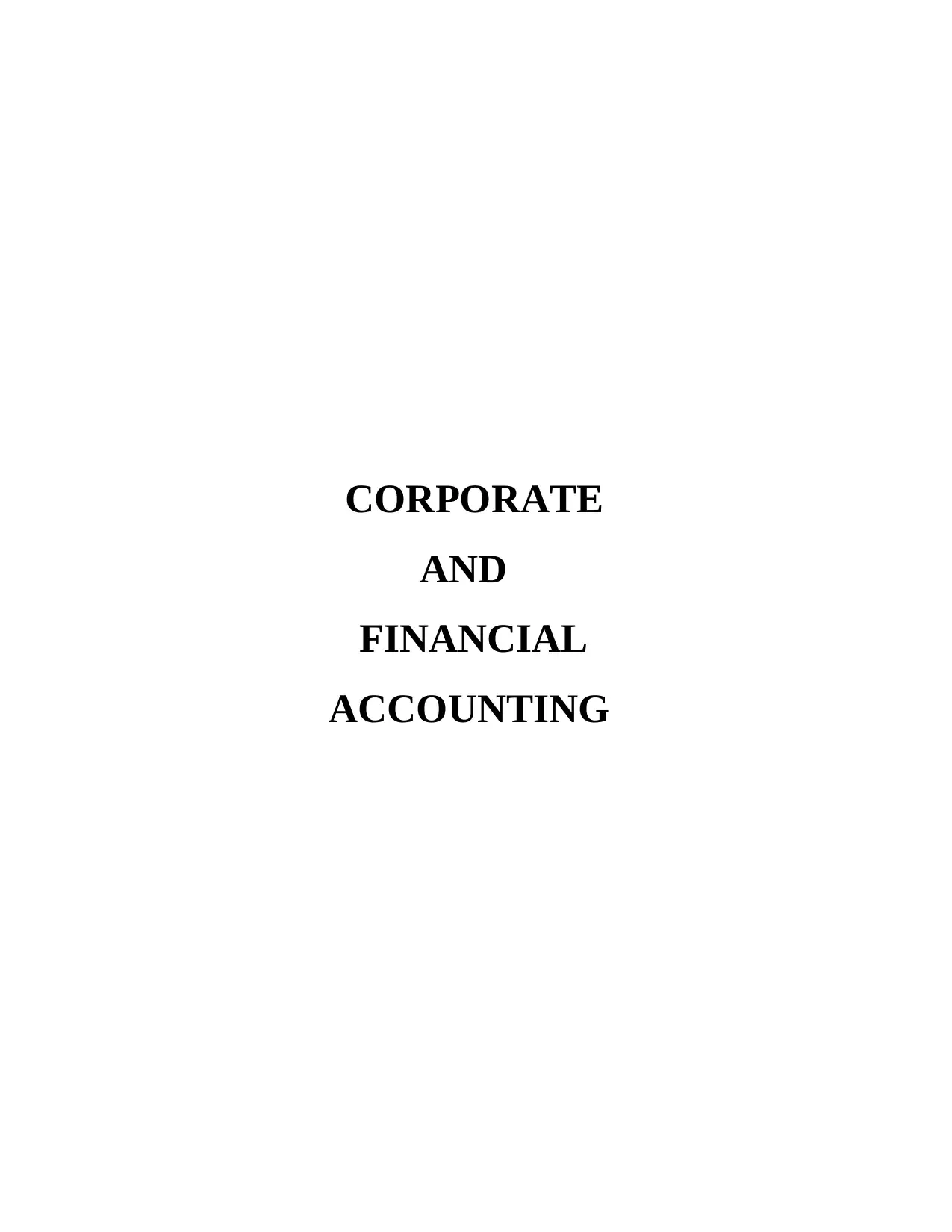
CORPORATE
AND
FINANCIAL
ACCOUNTING
AND
FINANCIAL
ACCOUNTING
Paraphrase This Document
Need a fresh take? Get an instant paraphrase of this document with our AI Paraphraser
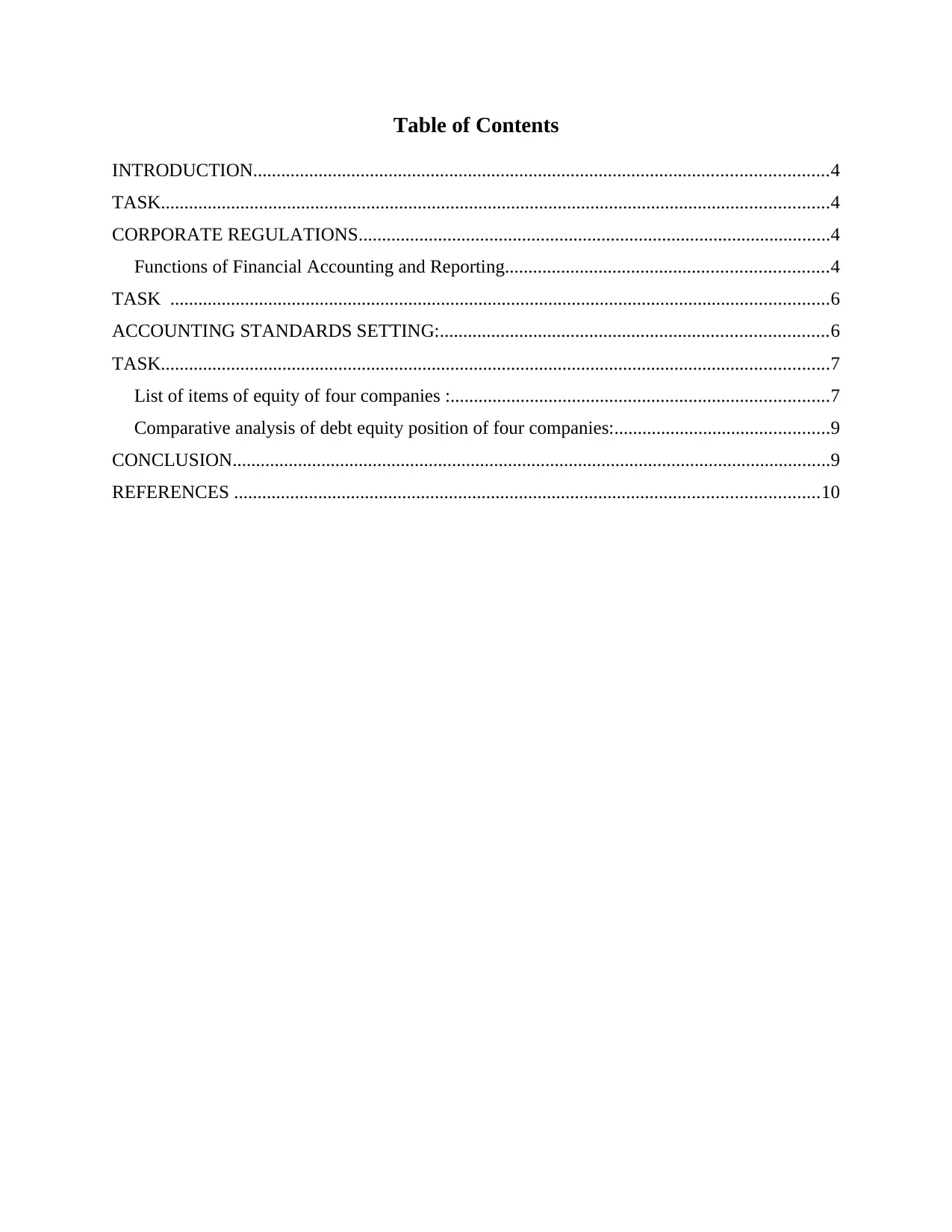
Table of Contents
INTRODUCTION...........................................................................................................................4
TASK...............................................................................................................................................4
CORPORATE REGULATIONS.....................................................................................................4
Functions of Financial Accounting and Reporting.....................................................................4
TASK .............................................................................................................................................6
ACCOUNTING STANDARDS SETTING:...................................................................................6
TASK...............................................................................................................................................7
List of items of equity of four companies :.................................................................................7
Comparative analysis of debt equity position of four companies:..............................................9
CONCLUSION................................................................................................................................9
REFERENCES .............................................................................................................................10
INTRODUCTION...........................................................................................................................4
TASK...............................................................................................................................................4
CORPORATE REGULATIONS.....................................................................................................4
Functions of Financial Accounting and Reporting.....................................................................4
TASK .............................................................................................................................................6
ACCOUNTING STANDARDS SETTING:...................................................................................6
TASK...............................................................................................................................................7
List of items of equity of four companies :.................................................................................7
Comparative analysis of debt equity position of four companies:..............................................9
CONCLUSION................................................................................................................................9
REFERENCES .............................................................................................................................10
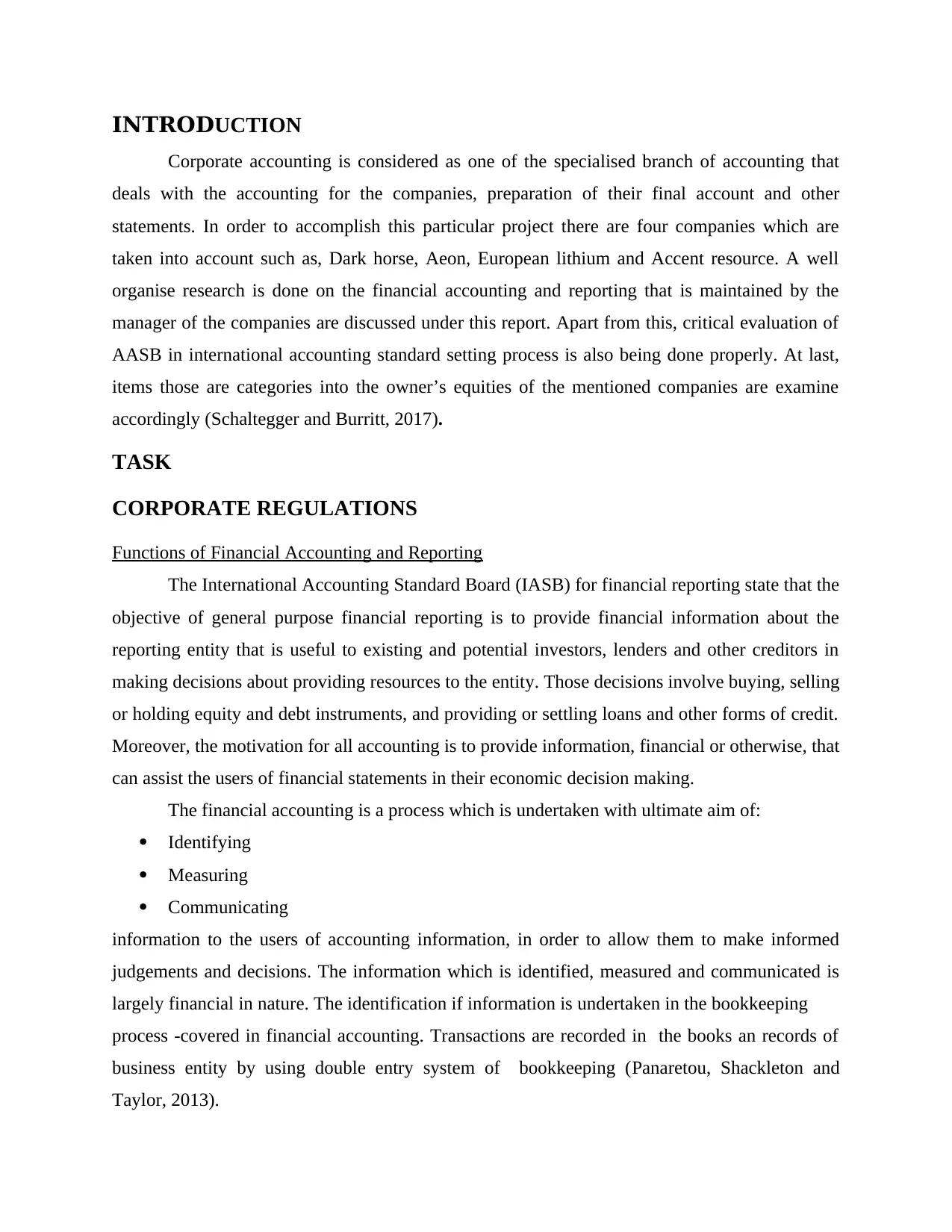
INTRODUCTION
Corporate accounting is considered as one of the specialised branch of accounting that
deals with the accounting for the companies, preparation of their final account and other
statements. In order to accomplish this particular project there are four companies which are
taken into account such as, Dark horse, Aeon, European lithium and Accent resource. A well
organise research is done on the financial accounting and reporting that is maintained by the
manager of the companies are discussed under this report. Apart from this, critical evaluation of
AASB in international accounting standard setting process is also being done properly. At last,
items those are categories into the owner’s equities of the mentioned companies are examine
accordingly (Schaltegger and Burritt, 2017).
TASK
CORPORATE REGULATIONS
Functions of Financial Accounting and Reporting
The International Accounting Standard Board (IASB) for financial reporting state that the
objective of general purpose financial reporting is to provide financial information about the
reporting entity that is useful to existing and potential investors, lenders and other creditors in
making decisions about providing resources to the entity. Those decisions involve buying, selling
or holding equity and debt instruments, and providing or settling loans and other forms of credit.
Moreover, the motivation for all accounting is to provide information, financial or otherwise, that
can assist the users of financial statements in their economic decision making.
The financial accounting is a process which is undertaken with ultimate aim of:
Identifying
Measuring
Communicating
information to the users of accounting information, in order to allow them to make informed
judgements and decisions. The information which is identified, measured and communicated is
largely financial in nature. The identification if information is undertaken in the bookkeeping
process -covered in financial accounting. Transactions are recorded in the books an records of
business entity by using double entry system of bookkeeping (Panaretou, Shackleton and
Taylor, 2013).
Corporate accounting is considered as one of the specialised branch of accounting that
deals with the accounting for the companies, preparation of their final account and other
statements. In order to accomplish this particular project there are four companies which are
taken into account such as, Dark horse, Aeon, European lithium and Accent resource. A well
organise research is done on the financial accounting and reporting that is maintained by the
manager of the companies are discussed under this report. Apart from this, critical evaluation of
AASB in international accounting standard setting process is also being done properly. At last,
items those are categories into the owner’s equities of the mentioned companies are examine
accordingly (Schaltegger and Burritt, 2017).
TASK
CORPORATE REGULATIONS
Functions of Financial Accounting and Reporting
The International Accounting Standard Board (IASB) for financial reporting state that the
objective of general purpose financial reporting is to provide financial information about the
reporting entity that is useful to existing and potential investors, lenders and other creditors in
making decisions about providing resources to the entity. Those decisions involve buying, selling
or holding equity and debt instruments, and providing or settling loans and other forms of credit.
Moreover, the motivation for all accounting is to provide information, financial or otherwise, that
can assist the users of financial statements in their economic decision making.
The financial accounting is a process which is undertaken with ultimate aim of:
Identifying
Measuring
Communicating
information to the users of accounting information, in order to allow them to make informed
judgements and decisions. The information which is identified, measured and communicated is
largely financial in nature. The identification if information is undertaken in the bookkeeping
process -covered in financial accounting. Transactions are recorded in the books an records of
business entity by using double entry system of bookkeeping (Panaretou, Shackleton and
Taylor, 2013).
⊘ This is a preview!⊘
Do you want full access?
Subscribe today to unlock all pages.

Trusted by 1+ million students worldwide
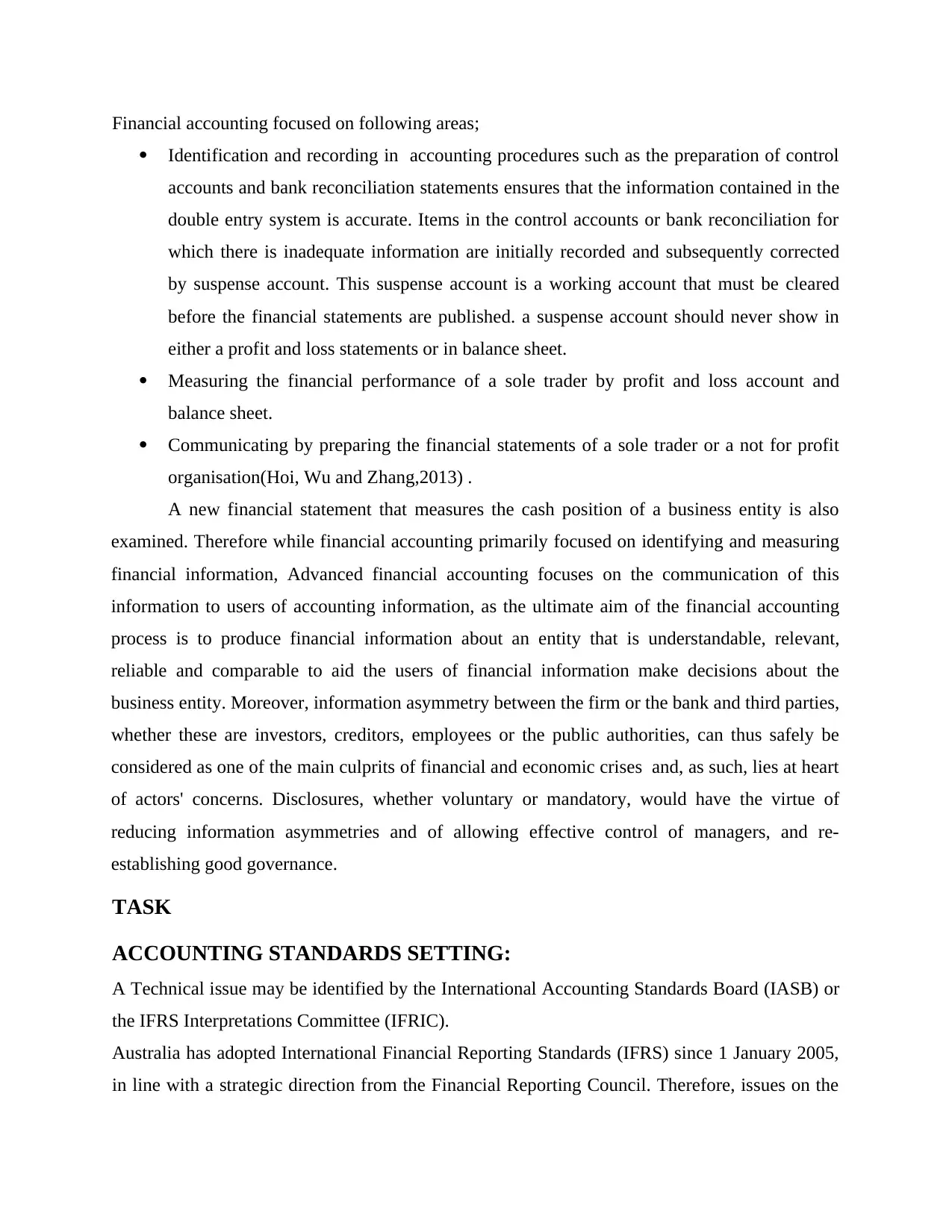
Financial accounting focused on following areas;
Identification and recording in accounting procedures such as the preparation of control
accounts and bank reconciliation statements ensures that the information contained in the
double entry system is accurate. Items in the control accounts or bank reconciliation for
which there is inadequate information are initially recorded and subsequently corrected
by suspense account. This suspense account is a working account that must be cleared
before the financial statements are published. a suspense account should never show in
either a profit and loss statements or in balance sheet.
Measuring the financial performance of a sole trader by profit and loss account and
balance sheet.
Communicating by preparing the financial statements of a sole trader or a not for profit
organisation(Hoi, Wu and Zhang,2013) .
A new financial statement that measures the cash position of a business entity is also
examined. Therefore while financial accounting primarily focused on identifying and measuring
financial information, Advanced financial accounting focuses on the communication of this
information to users of accounting information, as the ultimate aim of the financial accounting
process is to produce financial information about an entity that is understandable, relevant,
reliable and comparable to aid the users of financial information make decisions about the
business entity. Moreover, information asymmetry between the firm or the bank and third parties,
whether these are investors, creditors, employees or the public authorities, can thus safely be
considered as one of the main culprits of financial and economic crises and, as such, lies at heart
of actors' concerns. Disclosures, whether voluntary or mandatory, would have the virtue of
reducing information asymmetries and of allowing effective control of managers, and re-
establishing good governance.
TASK
ACCOUNTING STANDARDS SETTING:
A Technical issue may be identified by the International Accounting Standards Board (IASB) or
the IFRS Interpretations Committee (IFRIC).
Australia has adopted International Financial Reporting Standards (IFRS) since 1 January 2005,
in line with a strategic direction from the Financial Reporting Council. Therefore, issues on the
Identification and recording in accounting procedures such as the preparation of control
accounts and bank reconciliation statements ensures that the information contained in the
double entry system is accurate. Items in the control accounts or bank reconciliation for
which there is inadequate information are initially recorded and subsequently corrected
by suspense account. This suspense account is a working account that must be cleared
before the financial statements are published. a suspense account should never show in
either a profit and loss statements or in balance sheet.
Measuring the financial performance of a sole trader by profit and loss account and
balance sheet.
Communicating by preparing the financial statements of a sole trader or a not for profit
organisation(Hoi, Wu and Zhang,2013) .
A new financial statement that measures the cash position of a business entity is also
examined. Therefore while financial accounting primarily focused on identifying and measuring
financial information, Advanced financial accounting focuses on the communication of this
information to users of accounting information, as the ultimate aim of the financial accounting
process is to produce financial information about an entity that is understandable, relevant,
reliable and comparable to aid the users of financial information make decisions about the
business entity. Moreover, information asymmetry between the firm or the bank and third parties,
whether these are investors, creditors, employees or the public authorities, can thus safely be
considered as one of the main culprits of financial and economic crises and, as such, lies at heart
of actors' concerns. Disclosures, whether voluntary or mandatory, would have the virtue of
reducing information asymmetries and of allowing effective control of managers, and re-
establishing good governance.
TASK
ACCOUNTING STANDARDS SETTING:
A Technical issue may be identified by the International Accounting Standards Board (IASB) or
the IFRS Interpretations Committee (IFRIC).
Australia has adopted International Financial Reporting Standards (IFRS) since 1 January 2005,
in line with a strategic direction from the Financial Reporting Council. Therefore, issues on the
Paraphrase This Document
Need a fresh take? Get an instant paraphrase of this document with our AI Paraphraser
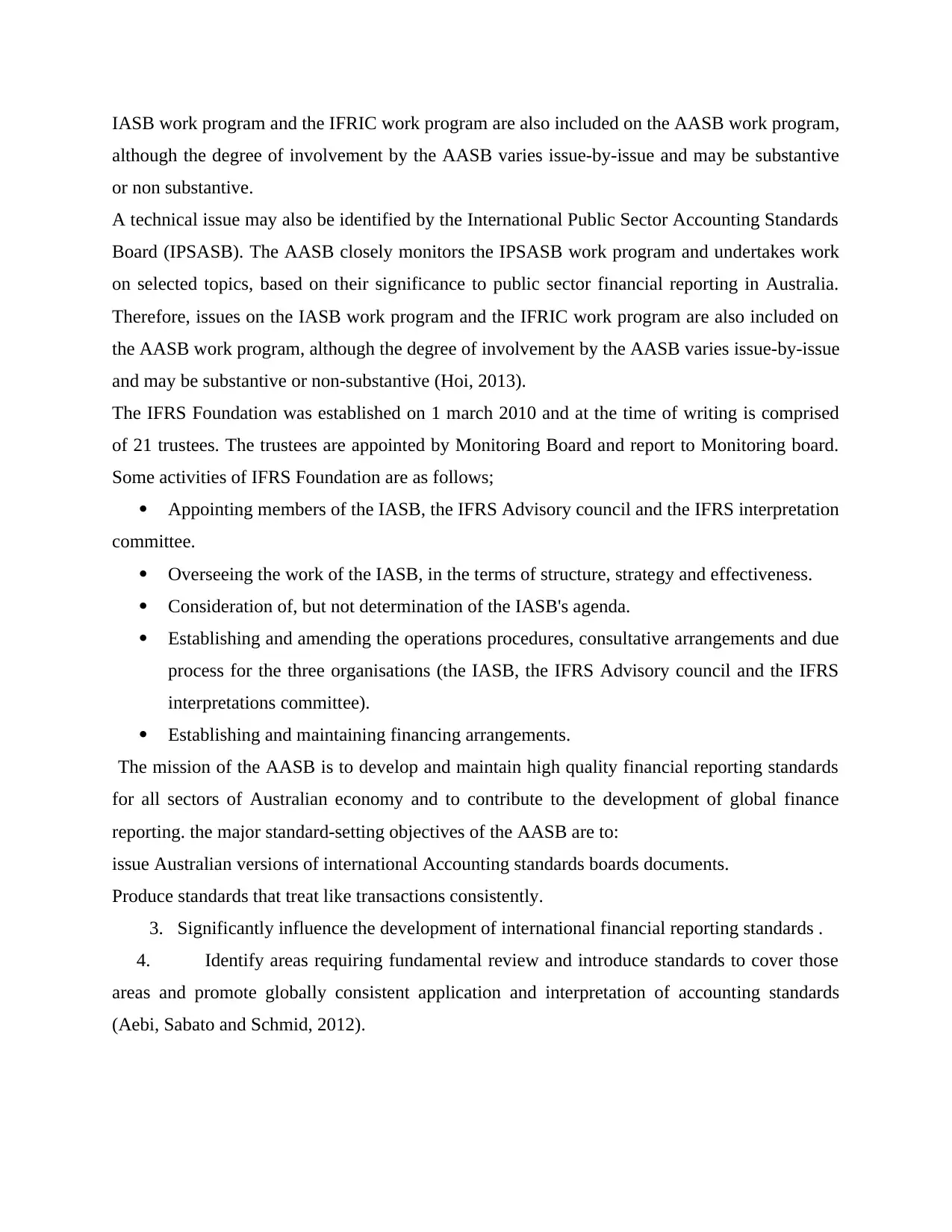
IASB work program and the IFRIC work program are also included on the AASB work program,
although the degree of involvement by the AASB varies issue-by-issue and may be substantive
or non substantive.
A technical issue may also be identified by the International Public Sector Accounting Standards
Board (IPSASB). The AASB closely monitors the IPSASB work program and undertakes work
on selected topics, based on their significance to public sector financial reporting in Australia.
Therefore, issues on the IASB work program and the IFRIC work program are also included on
the AASB work program, although the degree of involvement by the AASB varies issue-by-issue
and may be substantive or non-substantive (Hoi, 2013).
The IFRS Foundation was established on 1 march 2010 and at the time of writing is comprised
of 21 trustees. The trustees are appointed by Monitoring Board and report to Monitoring board.
Some activities of IFRS Foundation are as follows;
Appointing members of the IASB, the IFRS Advisory council and the IFRS interpretation
committee.
Overseeing the work of the IASB, in the terms of structure, strategy and effectiveness.
Consideration of, but not determination of the IASB's agenda.
Establishing and amending the operations procedures, consultative arrangements and due
process for the three organisations (the IASB, the IFRS Advisory council and the IFRS
interpretations committee).
Establishing and maintaining financing arrangements.
The mission of the AASB is to develop and maintain high quality financial reporting standards
for all sectors of Australian economy and to contribute to the development of global finance
reporting. the major standard-setting objectives of the AASB are to:
issue Australian versions of international Accounting standards boards documents.
Produce standards that treat like transactions consistently.
3. Significantly influence the development of international financial reporting standards .
4. Identify areas requiring fundamental review and introduce standards to cover those
areas and promote globally consistent application and interpretation of accounting standards
(Aebi, Sabato and Schmid, 2012).
although the degree of involvement by the AASB varies issue-by-issue and may be substantive
or non substantive.
A technical issue may also be identified by the International Public Sector Accounting Standards
Board (IPSASB). The AASB closely monitors the IPSASB work program and undertakes work
on selected topics, based on their significance to public sector financial reporting in Australia.
Therefore, issues on the IASB work program and the IFRIC work program are also included on
the AASB work program, although the degree of involvement by the AASB varies issue-by-issue
and may be substantive or non-substantive (Hoi, 2013).
The IFRS Foundation was established on 1 march 2010 and at the time of writing is comprised
of 21 trustees. The trustees are appointed by Monitoring Board and report to Monitoring board.
Some activities of IFRS Foundation are as follows;
Appointing members of the IASB, the IFRS Advisory council and the IFRS interpretation
committee.
Overseeing the work of the IASB, in the terms of structure, strategy and effectiveness.
Consideration of, but not determination of the IASB's agenda.
Establishing and amending the operations procedures, consultative arrangements and due
process for the three organisations (the IASB, the IFRS Advisory council and the IFRS
interpretations committee).
Establishing and maintaining financing arrangements.
The mission of the AASB is to develop and maintain high quality financial reporting standards
for all sectors of Australian economy and to contribute to the development of global finance
reporting. the major standard-setting objectives of the AASB are to:
issue Australian versions of international Accounting standards boards documents.
Produce standards that treat like transactions consistently.
3. Significantly influence the development of international financial reporting standards .
4. Identify areas requiring fundamental review and introduce standards to cover those
areas and promote globally consistent application and interpretation of accounting standards
(Aebi, Sabato and Schmid, 2012).
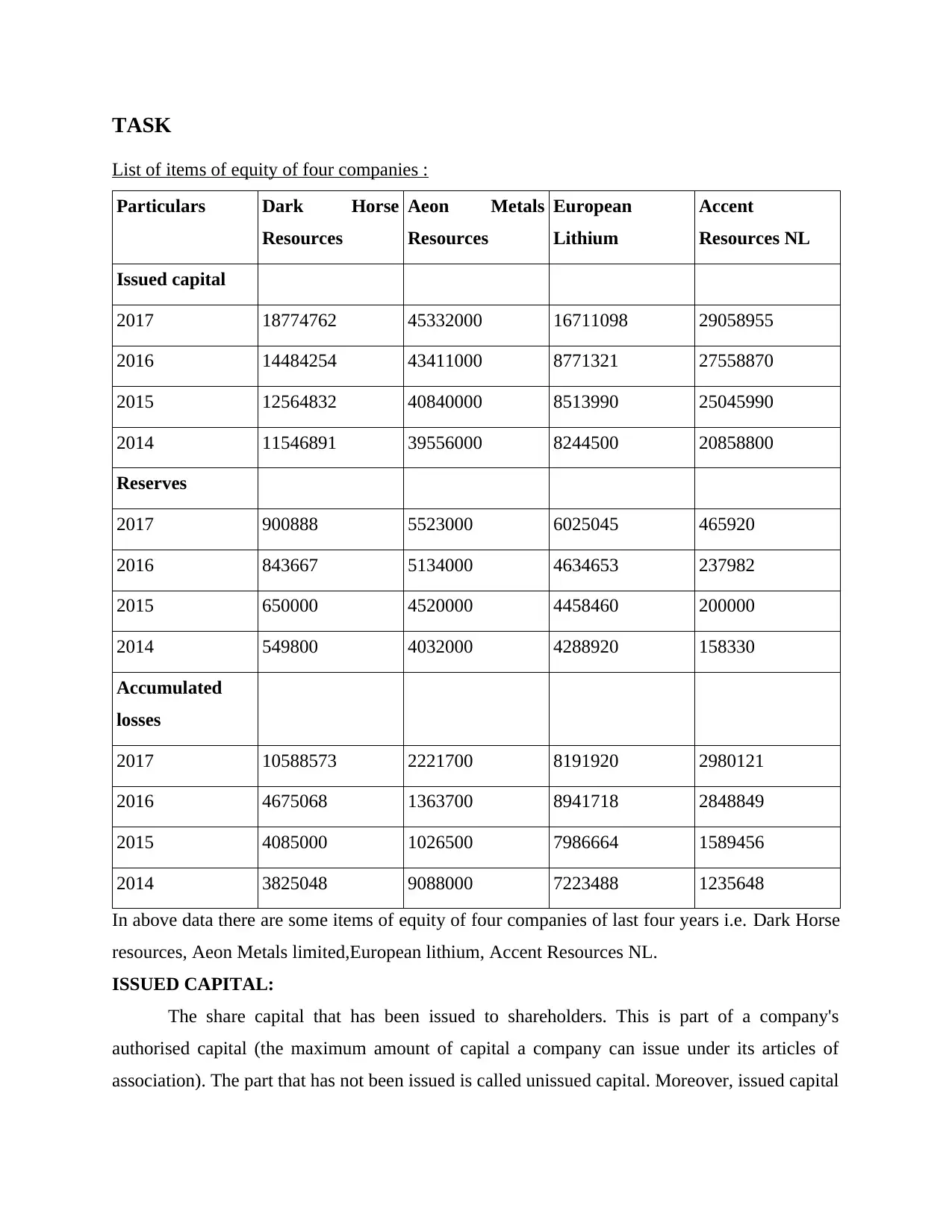
TASK
List of items of equity of four companies :
Particulars Dark Horse
Resources
Aeon Metals
Resources
European
Lithium
Accent
Resources NL
Issued capital
2017 18774762 45332000 16711098 29058955
2016 14484254 43411000 8771321 27558870
2015 12564832 40840000 8513990 25045990
2014 11546891 39556000 8244500 20858800
Reserves
2017 900888 5523000 6025045 465920
2016 843667 5134000 4634653 237982
2015 650000 4520000 4458460 200000
2014 549800 4032000 4288920 158330
Accumulated
losses
2017 10588573 2221700 8191920 2980121
2016 4675068 1363700 8941718 2848849
2015 4085000 1026500 7986664 1589456
2014 3825048 9088000 7223488 1235648
In above data there are some items of equity of four companies of last four years i.e. Dark Horse
resources, Aeon Metals limited,European lithium, Accent Resources NL.
ISSUED CAPITAL:
The share capital that has been issued to shareholders. This is part of a company's
authorised capital (the maximum amount of capital a company can issue under its articles of
association). The part that has not been issued is called unissued capital. Moreover, issued capital
List of items of equity of four companies :
Particulars Dark Horse
Resources
Aeon Metals
Resources
European
Lithium
Accent
Resources NL
Issued capital
2017 18774762 45332000 16711098 29058955
2016 14484254 43411000 8771321 27558870
2015 12564832 40840000 8513990 25045990
2014 11546891 39556000 8244500 20858800
Reserves
2017 900888 5523000 6025045 465920
2016 843667 5134000 4634653 237982
2015 650000 4520000 4458460 200000
2014 549800 4032000 4288920 158330
Accumulated
losses
2017 10588573 2221700 8191920 2980121
2016 4675068 1363700 8941718 2848849
2015 4085000 1026500 7986664 1589456
2014 3825048 9088000 7223488 1235648
In above data there are some items of equity of four companies of last four years i.e. Dark Horse
resources, Aeon Metals limited,European lithium, Accent Resources NL.
ISSUED CAPITAL:
The share capital that has been issued to shareholders. This is part of a company's
authorised capital (the maximum amount of capital a company can issue under its articles of
association). The part that has not been issued is called unissued capital. Moreover, issued capital
⊘ This is a preview!⊘
Do you want full access?
Subscribe today to unlock all pages.

Trusted by 1+ million students worldwide
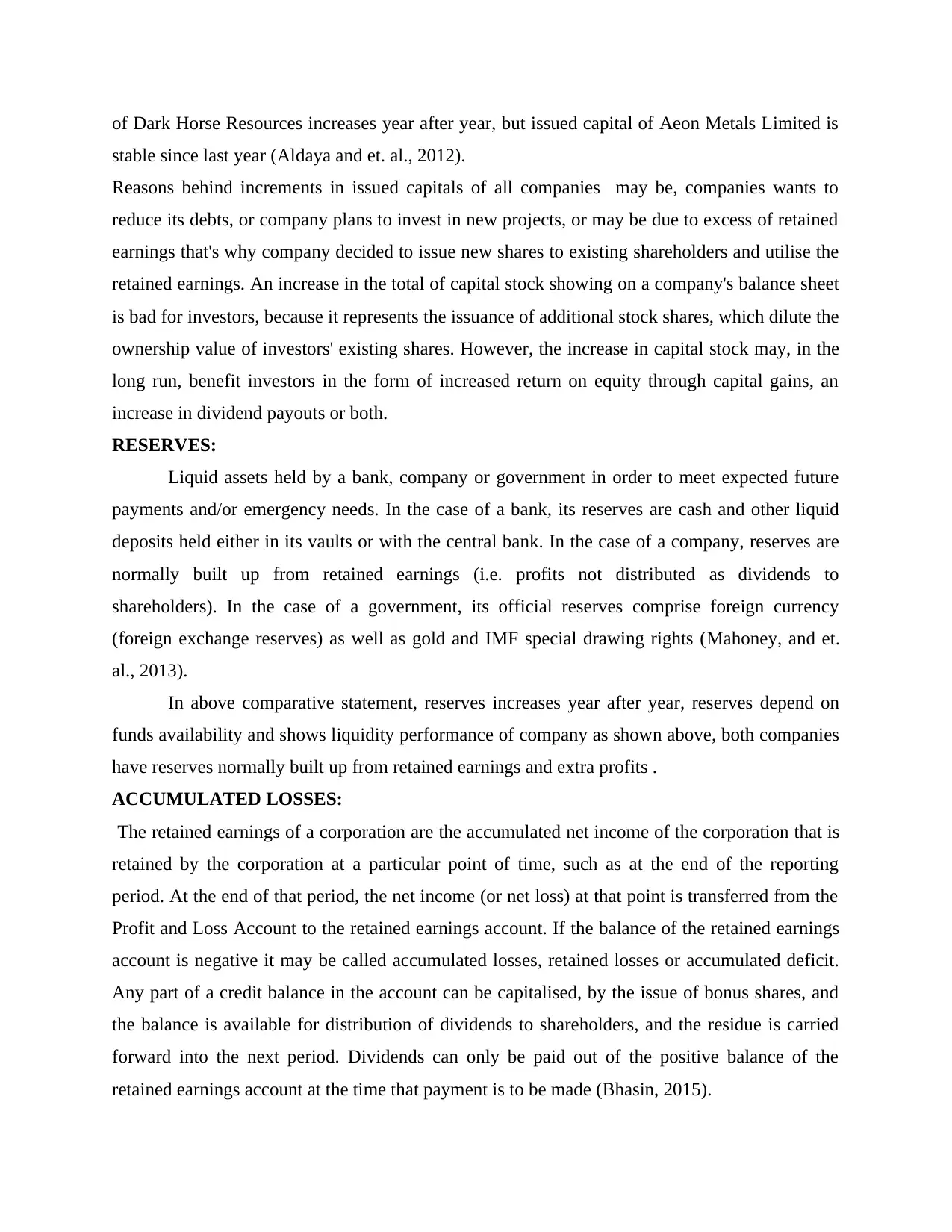
of Dark Horse Resources increases year after year, but issued capital of Aeon Metals Limited is
stable since last year (Aldaya and et. al., 2012).
Reasons behind increments in issued capitals of all companies may be, companies wants to
reduce its debts, or company plans to invest in new projects, or may be due to excess of retained
earnings that's why company decided to issue new shares to existing shareholders and utilise the
retained earnings. An increase in the total of capital stock showing on a company's balance sheet
is bad for investors, because it represents the issuance of additional stock shares, which dilute the
ownership value of investors' existing shares. However, the increase in capital stock may, in the
long run, benefit investors in the form of increased return on equity through capital gains, an
increase in dividend payouts or both.
RESERVES:
Liquid assets held by a bank, company or government in order to meet expected future
payments and/or emergency needs. In the case of a bank, its reserves are cash and other liquid
deposits held either in its vaults or with the central bank. In the case of a company, reserves are
normally built up from retained earnings (i.e. profits not distributed as dividends to
shareholders). In the case of a government, its official reserves comprise foreign currency
(foreign exchange reserves) as well as gold and IMF special drawing rights (Mahoney, and et.
al., 2013).
In above comparative statement, reserves increases year after year, reserves depend on
funds availability and shows liquidity performance of company as shown above, both companies
have reserves normally built up from retained earnings and extra profits .
ACCUMULATED LOSSES:
The retained earnings of a corporation are the accumulated net income of the corporation that is
retained by the corporation at a particular point of time, such as at the end of the reporting
period. At the end of that period, the net income (or net loss) at that point is transferred from the
Profit and Loss Account to the retained earnings account. If the balance of the retained earnings
account is negative it may be called accumulated losses, retained losses or accumulated deficit.
Any part of a credit balance in the account can be capitalised, by the issue of bonus shares, and
the balance is available for distribution of dividends to shareholders, and the residue is carried
forward into the next period. Dividends can only be paid out of the positive balance of the
retained earnings account at the time that payment is to be made (Bhasin, 2015).
stable since last year (Aldaya and et. al., 2012).
Reasons behind increments in issued capitals of all companies may be, companies wants to
reduce its debts, or company plans to invest in new projects, or may be due to excess of retained
earnings that's why company decided to issue new shares to existing shareholders and utilise the
retained earnings. An increase in the total of capital stock showing on a company's balance sheet
is bad for investors, because it represents the issuance of additional stock shares, which dilute the
ownership value of investors' existing shares. However, the increase in capital stock may, in the
long run, benefit investors in the form of increased return on equity through capital gains, an
increase in dividend payouts or both.
RESERVES:
Liquid assets held by a bank, company or government in order to meet expected future
payments and/or emergency needs. In the case of a bank, its reserves are cash and other liquid
deposits held either in its vaults or with the central bank. In the case of a company, reserves are
normally built up from retained earnings (i.e. profits not distributed as dividends to
shareholders). In the case of a government, its official reserves comprise foreign currency
(foreign exchange reserves) as well as gold and IMF special drawing rights (Mahoney, and et.
al., 2013).
In above comparative statement, reserves increases year after year, reserves depend on
funds availability and shows liquidity performance of company as shown above, both companies
have reserves normally built up from retained earnings and extra profits .
ACCUMULATED LOSSES:
The retained earnings of a corporation are the accumulated net income of the corporation that is
retained by the corporation at a particular point of time, such as at the end of the reporting
period. At the end of that period, the net income (or net loss) at that point is transferred from the
Profit and Loss Account to the retained earnings account. If the balance of the retained earnings
account is negative it may be called accumulated losses, retained losses or accumulated deficit.
Any part of a credit balance in the account can be capitalised, by the issue of bonus shares, and
the balance is available for distribution of dividends to shareholders, and the residue is carried
forward into the next period. Dividends can only be paid out of the positive balance of the
retained earnings account at the time that payment is to be made (Bhasin, 2015).
Paraphrase This Document
Need a fresh take? Get an instant paraphrase of this document with our AI Paraphraser
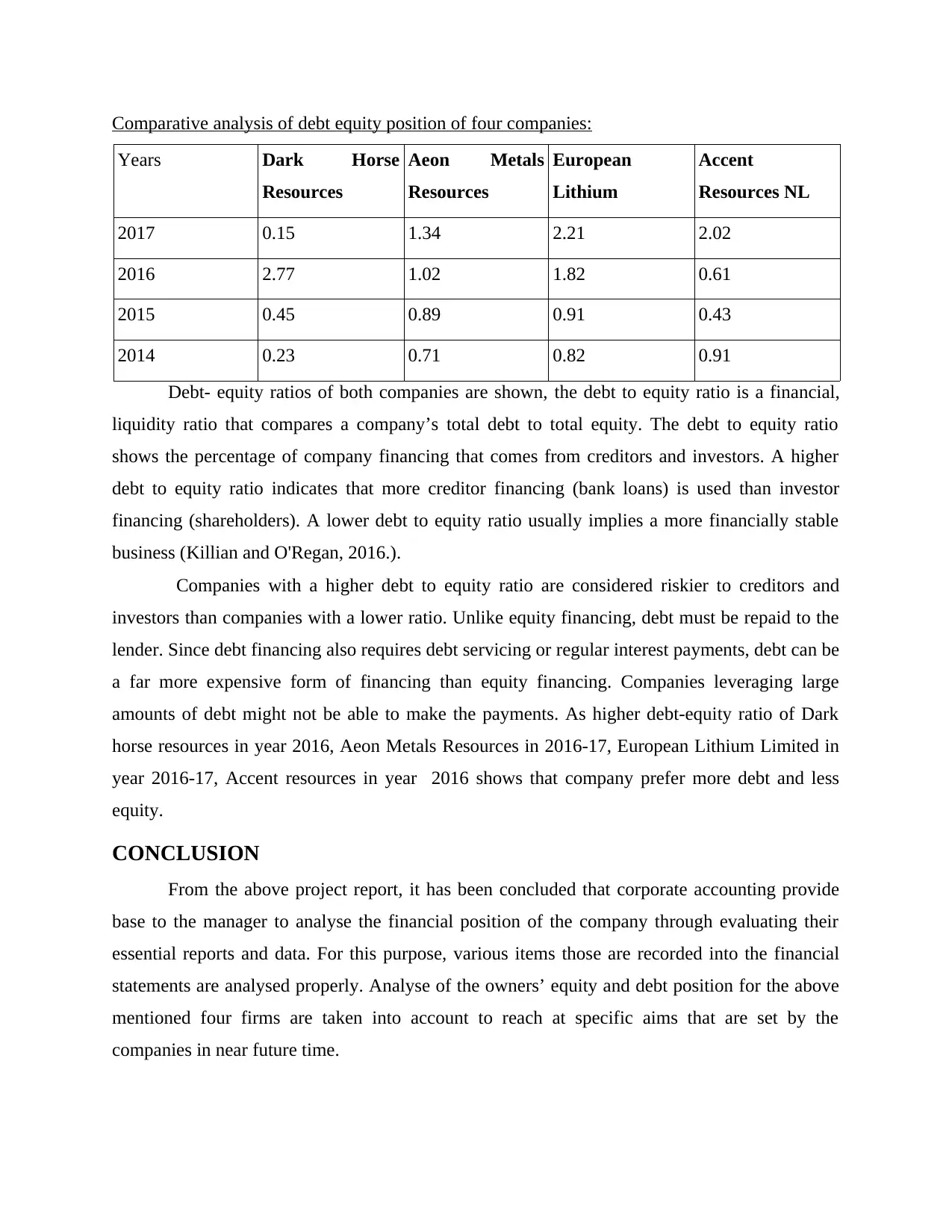
Comparative analysis of debt equity position of four companies:
Years Dark Horse
Resources
Aeon Metals
Resources
European
Lithium
Accent
Resources NL
2017 0.15 1.34 2.21 2.02
2016 2.77 1.02 1.82 0.61
2015 0.45 0.89 0.91 0.43
2014 0.23 0.71 0.82 0.91
Debt- equity ratios of both companies are shown, the debt to equity ratio is a financial,
liquidity ratio that compares a company’s total debt to total equity. The debt to equity ratio
shows the percentage of company financing that comes from creditors and investors. A higher
debt to equity ratio indicates that more creditor financing (bank loans) is used than investor
financing (shareholders). A lower debt to equity ratio usually implies a more financially stable
business (Killian and O'Regan, 2016.).
Companies with a higher debt to equity ratio are considered riskier to creditors and
investors than companies with a lower ratio. Unlike equity financing, debt must be repaid to the
lender. Since debt financing also requires debt servicing or regular interest payments, debt can be
a far more expensive form of financing than equity financing. Companies leveraging large
amounts of debt might not be able to make the payments. As higher debt-equity ratio of Dark
horse resources in year 2016, Aeon Metals Resources in 2016-17, European Lithium Limited in
year 2016-17, Accent resources in year 2016 shows that company prefer more debt and less
equity.
CONCLUSION
From the above project report, it has been concluded that corporate accounting provide
base to the manager to analyse the financial position of the company through evaluating their
essential reports and data. For this purpose, various items those are recorded into the financial
statements are analysed properly. Analyse of the owners’ equity and debt position for the above
mentioned four firms are taken into account to reach at specific aims that are set by the
companies in near future time.
Years Dark Horse
Resources
Aeon Metals
Resources
European
Lithium
Accent
Resources NL
2017 0.15 1.34 2.21 2.02
2016 2.77 1.02 1.82 0.61
2015 0.45 0.89 0.91 0.43
2014 0.23 0.71 0.82 0.91
Debt- equity ratios of both companies are shown, the debt to equity ratio is a financial,
liquidity ratio that compares a company’s total debt to total equity. The debt to equity ratio
shows the percentage of company financing that comes from creditors and investors. A higher
debt to equity ratio indicates that more creditor financing (bank loans) is used than investor
financing (shareholders). A lower debt to equity ratio usually implies a more financially stable
business (Killian and O'Regan, 2016.).
Companies with a higher debt to equity ratio are considered riskier to creditors and
investors than companies with a lower ratio. Unlike equity financing, debt must be repaid to the
lender. Since debt financing also requires debt servicing or regular interest payments, debt can be
a far more expensive form of financing than equity financing. Companies leveraging large
amounts of debt might not be able to make the payments. As higher debt-equity ratio of Dark
horse resources in year 2016, Aeon Metals Resources in 2016-17, European Lithium Limited in
year 2016-17, Accent resources in year 2016 shows that company prefer more debt and less
equity.
CONCLUSION
From the above project report, it has been concluded that corporate accounting provide
base to the manager to analyse the financial position of the company through evaluating their
essential reports and data. For this purpose, various items those are recorded into the financial
statements are analysed properly. Analyse of the owners’ equity and debt position for the above
mentioned four firms are taken into account to reach at specific aims that are set by the
companies in near future time.
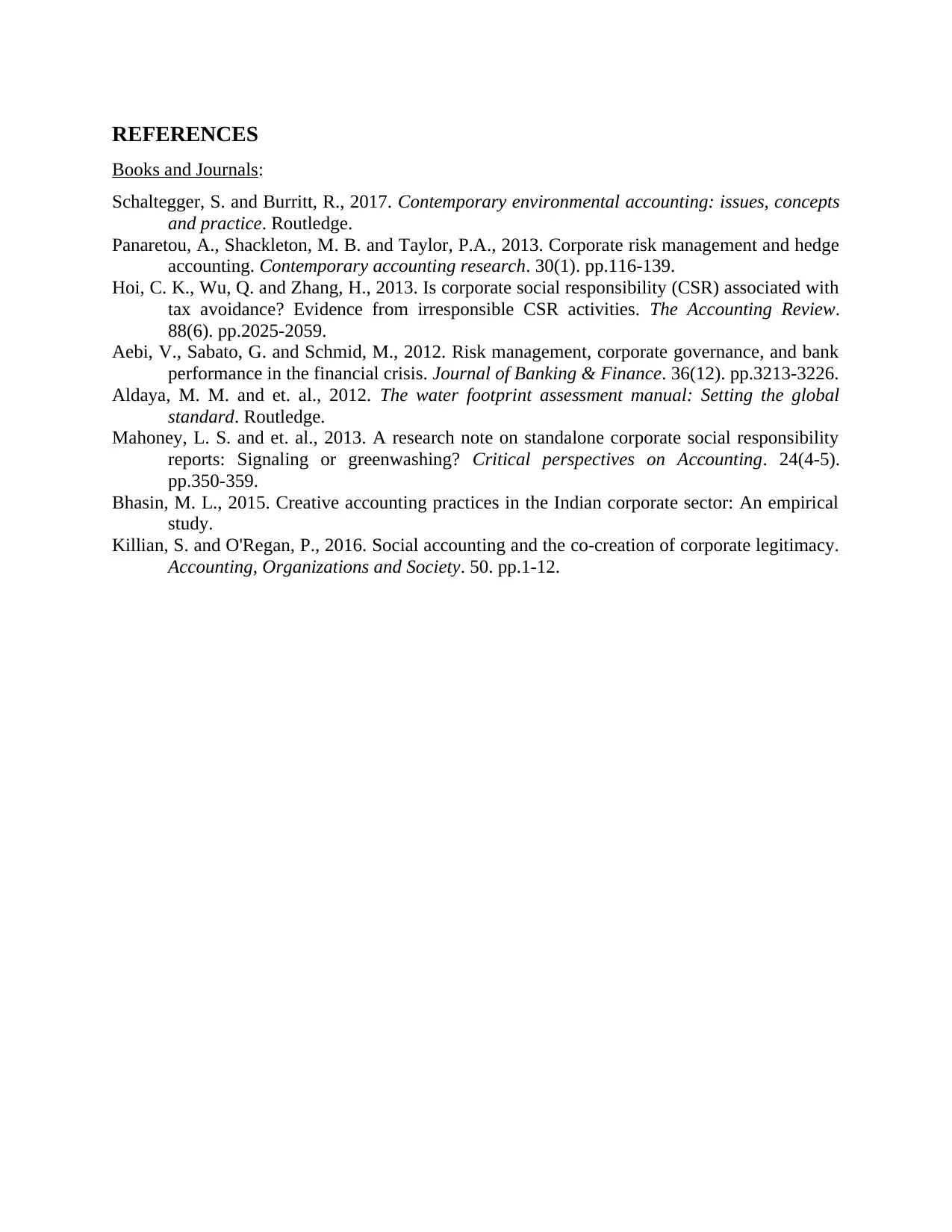
REFERENCES
Books and Journals:
Schaltegger, S. and Burritt, R., 2017. Contemporary environmental accounting: issues, concepts
and practice. Routledge.
Panaretou, A., Shackleton, M. B. and Taylor, P.A., 2013. Corporate risk management and hedge
accounting. Contemporary accounting research. 30(1). pp.116-139.
Hoi, C. K., Wu, Q. and Zhang, H., 2013. Is corporate social responsibility (CSR) associated with
tax avoidance? Evidence from irresponsible CSR activities. The Accounting Review.
88(6). pp.2025-2059.
Aebi, V., Sabato, G. and Schmid, M., 2012. Risk management, corporate governance, and bank
performance in the financial crisis. Journal of Banking & Finance. 36(12). pp.3213-3226.
Aldaya, M. M. and et. al., 2012. The water footprint assessment manual: Setting the global
standard. Routledge.
Mahoney, L. S. and et. al., 2013. A research note on standalone corporate social responsibility
reports: Signaling or greenwashing? Critical perspectives on Accounting. 24(4-5).
pp.350-359.
Bhasin, M. L., 2015. Creative accounting practices in the Indian corporate sector: An empirical
study.
Killian, S. and O'Regan, P., 2016. Social accounting and the co-creation of corporate legitimacy.
Accounting, Organizations and Society. 50. pp.1-12.
Books and Journals:
Schaltegger, S. and Burritt, R., 2017. Contemporary environmental accounting: issues, concepts
and practice. Routledge.
Panaretou, A., Shackleton, M. B. and Taylor, P.A., 2013. Corporate risk management and hedge
accounting. Contemporary accounting research. 30(1). pp.116-139.
Hoi, C. K., Wu, Q. and Zhang, H., 2013. Is corporate social responsibility (CSR) associated with
tax avoidance? Evidence from irresponsible CSR activities. The Accounting Review.
88(6). pp.2025-2059.
Aebi, V., Sabato, G. and Schmid, M., 2012. Risk management, corporate governance, and bank
performance in the financial crisis. Journal of Banking & Finance. 36(12). pp.3213-3226.
Aldaya, M. M. and et. al., 2012. The water footprint assessment manual: Setting the global
standard. Routledge.
Mahoney, L. S. and et. al., 2013. A research note on standalone corporate social responsibility
reports: Signaling or greenwashing? Critical perspectives on Accounting. 24(4-5).
pp.350-359.
Bhasin, M. L., 2015. Creative accounting practices in the Indian corporate sector: An empirical
study.
Killian, S. and O'Regan, P., 2016. Social accounting and the co-creation of corporate legitimacy.
Accounting, Organizations and Society. 50. pp.1-12.
⊘ This is a preview!⊘
Do you want full access?
Subscribe today to unlock all pages.

Trusted by 1+ million students worldwide
1 out of 9
Related Documents
Your All-in-One AI-Powered Toolkit for Academic Success.
+13062052269
info@desklib.com
Available 24*7 on WhatsApp / Email
![[object Object]](/_next/static/media/star-bottom.7253800d.svg)
Unlock your academic potential
Copyright © 2020–2025 A2Z Services. All Rights Reserved. Developed and managed by ZUCOL.




